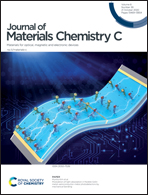Dicyanovinyl-based fluorescent sensors for dual mechanism amine sensing†
Abstract
Food wastage due to spoiling is a global economic issue and contributes to over-farming and overfishing with real environmental consequences. Smart food packaging is a promising solution to this problem, the concept of which is to incorporate responsive sensors that allow direct monitoring of the gasses released from the decay of food into a label that provides a visual indicator to the consumer as to whether the food is fresh or has spoiled. Here we report two dicyanovinyl-fluorene-benzothiadiazole-based fluorescent compounds, K12 and K12b, both of which showed rapid response to biogenic amines via two independent mechanisms. When primary alkyl amines were present in solution, they underwent an aza-Michael addition with the dicyanovinyl group of the sensing material, resulting in a rapid colour change. The reaction products of K12 and K12b with primary amines showed a decrease and increase in the fluorescence quantum yield, respectively, enabling a unique dual-sensor array with turn-off/turn-on response. In addition, fluorescence quenching via photoinduced hole transfer was observed in the solid-state sensor films with a wide range of primary, secondary and tertiary amines, enabling rapid and sensitive detection of amine vapours. Finally, we show as proof-of-concept that the fluorescence quenching response of sensing films was observable at cadaverine concentrations relevant to the food industry.

- This article is part of the themed collection: 10th Anniversary: Dedicated Authors


 Please wait while we load your content...
Please wait while we load your content...